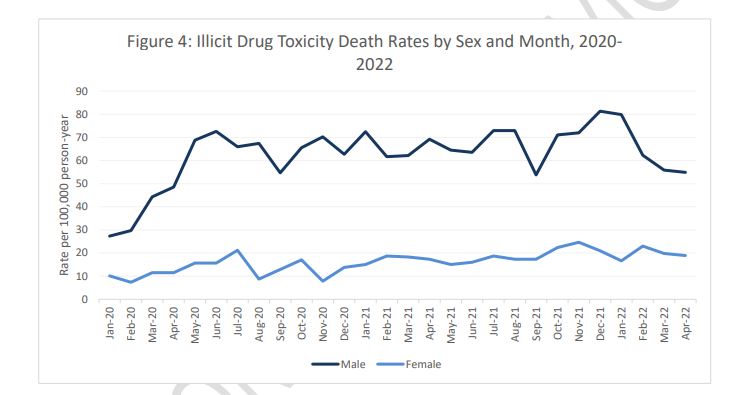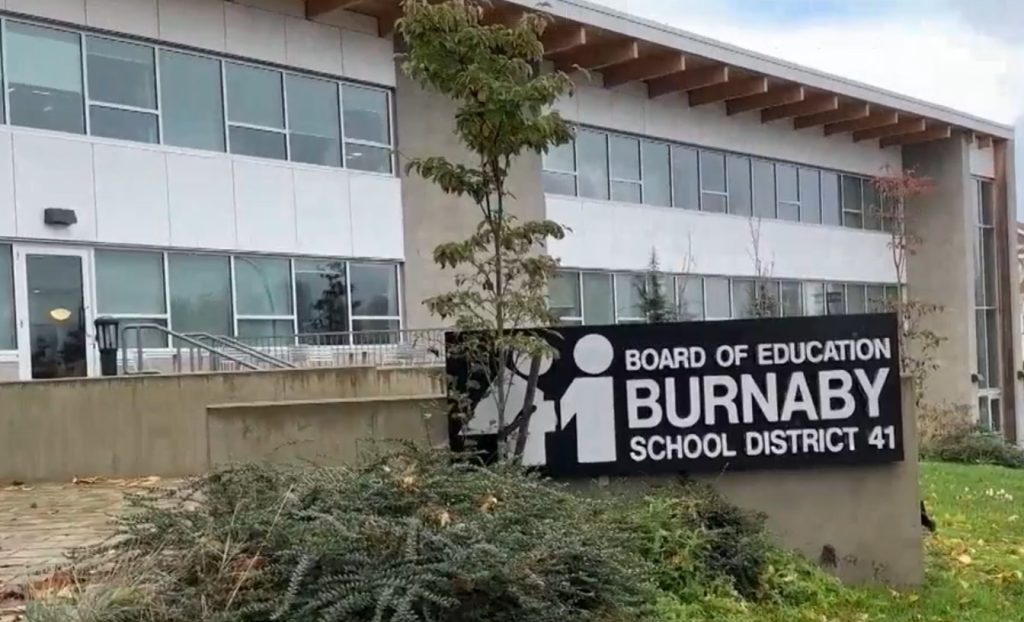B.C. records 161 deaths in April due to toxic drugs

Posted June 9, 2022 11:41 am.
Last Updated June 9, 2022 8:58 pm.
April was yet another devastating month for toxic drug deaths in B.C., with 161 lives lost.
This is the second-highest number ever recorded in the month of April, and equates to more than five deaths per day. The 161 deaths represents a 13 per cent decrease compared to April 2021.
The BC Coroners Service says most of these deaths are happening in homes, noting none were at supervised consumption sites.
The rate of deaths among men has been falling since January. However, the rate among women has remained relatively steady.

(Courtesy: BC Coroners Service)
In all of 2022 so far, fentanyl was found in 83 per cent of drug samples that tested positive. Last year, the substance was found in 86 per cent of positive tests.
Cocaine and methamphetamine/amphetamine are also found in high percentages of positive tests.
Last week, B.C. was granted an exemption that will allow the province to decriminalize small amounts of certain drugs for personal possession. The exemption will apply to all adults over the age of 18 within B.C. Personal possession only up to a cumulative amount of 2.5 grams of opioids, cocaine, methamphetamine, and MDMA are included in this.
“One of the reasons that people continue to lose their lives is the stigma that surrounds addictions and substance use,” said Mental Health and Addictions Minister Sheila Malcolmson. “Shame and fear keep many people from accessing the care they need. The fear of being criminalized has led many people to hide addiction and use drugs alone – and using alone can mean dying alone.”

B.C.’s exemption period begins Jan. 31, 2023 and is set to be in place for three years, ending on Jan. 31, 2026. Health Canada notes the exemption may be revoked or replaced by another. During this period, there will be no arrests or charges against people who are found to have 2.5 grams or less of the substances listed above for personal use. The drugs will also not be seized.
Malcolmson says calls decriminalization a “critical step in B.C.’s fight against the toxic drug crisis.”
“It will break down the barriers that prevent people from getting life-saving supports, while interrupting the cycle of drug criminalization and poverty,” she said, adding there is “no magic bullet” to solving this issue.
Noting it has been nearly 100 days since the BC Coroners Service Death Review Panel, BC Liberal critic Trevor Halford accuses the NDP government of “ignoring its recommendations.”
“Despite the rhetoric, there continues to be little action and urgency from John Horgan and the NDP government as they disregard the life-saving goals and timelines laid out in this report.”
‘The problem is not getting better, it’s getting far worse’
Members of the Drug User Liberation Front and the Vancouver Area Network of Drug Users say regulated safe supply is desperately needed now.
For the 6th time community advocates in Vancouver handed out a regulated supply of cocaine, heroin, and methamphetamine after B.C. recorded the deaths in April due to toxic drugs.
“We’ve given 310 doses … each of these drugs rigorously tested cocaine, heroin and methamphetamine. And of the doses we’ve distributed, there have been zero, overdoses either fatal or non-fatal. So at the end of the day, the Drug User Liberation Front believes that if people know what they’re putting into their bodies … and the correct dose, they are both not at risk of drug toxicity, and much less risk of drug overdose,” Eris Nyx with DULF said.
Nyx says she feels numb to the reports of toxic drug deaths but it does not minimize the reality that the tragic crisis.
“In B.C. thee problem is not getting better, it’s getting far worse. And I sincerely believe so long as we do not act to regulate this market, it will continue to catastrophically spiral out of control and cause and create more death,” she said.
The proportion of toxic drug deaths among British Columbians aged 50 and up has been steadily rising over the past six years, to 38 per cent so far this year.
The cities of Vancouver, Surrey, and Victoria are seeing the most deaths. When it comes to the rates of illicit drug deaths, Northern Health Authority is seeing the highest (58 deaths per 100,000 people), followed by Vancouver Coastal Health (47 per 100,000 people).
Related articles:
-
6 years and 9,000 deaths: B.C. marks anniversary of toxic drug crisis
-
Six people under 19 among B.C.’s skyrocketing drug death toll
-
B.C. advocates say feds proposed lower threshold for drug decriminalization is harmful
The overall rate in B.C. is 41 deaths per 100,000 people.
April 14 marked six years since B.C. declared a public health emergency due to the opioid crisis. Since then, more than 9,500 people have died, and experts say the toxicity of drugs has only gotten worse.
With files from Claire Fenton and Hana Mae Nassar








